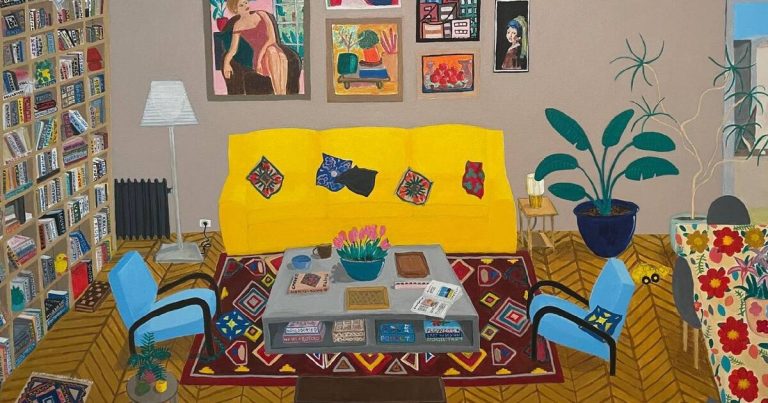Art Market
Annabel Keenan
“Buying art is primarily about personal experience,” Alberto Bemer, manager of Galleria Il Ponte in Florence, told Artsy. “Choose artists and artworks that resonate with your sensitivities and tastes – only what you really love.” Bemer raised perhaps the most important aspect of buying art: there is no one suitable way.
The way collectors buy and what should reflect their own tastes, aesthetics and values, whether filling walls or building them will have a collection that they will have for years. With countless artists and dealers working around the world, collectors have countless options, but this abundance can also be daunting and confusing. Indeed, errors and mistakes collected at all levels are not uncommon.
Artsy talks with experienced dealers and collectors to highlight five common mistakes New art buyers make and tips to avoid this.
1. Don’t know the artist’s story or the meaning of the artwork
When you buy art, you acquire more than the work itself. You can also buy the artist’s stories and what their creations mean. Unknown to these details can lead to disappointment, for example, the information about the work will not resonate with the buyer.
“We recommend collectors to do their homework and focus on the aesthetics of the work: do I like it? It fits in the “appearance” of my home; am I aware of the artist and specific work enough to make a acquisition?” The owner of his eponymous New York gallery Hollis Taggart said.
In addition to asking questions, dealers and experienced collectors also recommend interacting with different art scenes and meeting the artists at the gallery opening or event. They can also learn from the rich information provided online, such as artists and galleries’ websites and markets such as Artsy. “I started collecting my collections in a very organic way – getting my local network in New York and Los Angeles directly from the artist,” said collector Antonio Valverde, who is in his collection It is considered the work of Ernie Eugene Barnes, Larry Bell and Kennedy. Yanko. “At that time, it was all about personal connections; I picked out the works that I simply resonated and affordable.”
Recognizing the importance of education, Bailly Gallery in Paris and Geneva created a popular online series of short videos called “The Story” that provide context for artists and artworks as well as historical context. If such information is not easy to obtain, it is recommended to ask the dealer only any issues you may have.
2. Follow the wrong advice
Elliott Erwitt
57th Street Gallery1963
Edwynn Houk Gallery
A subtle and common mistake that collectors may make is following the wrong advice. False comparisons with auction results, following trends or buying things are because they think it is the best or most coveted piece, and here are some ways that can happen. But the best thing is not always the best for a collector. Purchasing based solely on external opinions may cause people living in their lives to change their hearts. In the beginning, self-education and asking questions like those raised by Taggart can help buyers develop their own tastes and horizons.
They can also avoid this mistake by having open conversations with the gallery to learn more about the artist’s roster and the process of collecting art in general. And, as people buy and start developing collectibles, art consultants may help. Both majors provide a keen knowledge of the market, and consultants can help collectors obtain works that may not be available.
“We have had our expertise for a long time,” said art consultant Nazy Nazhand. “It is this connoisseur and sober/independent professionalism that will help collectors build collections of legacy, investing in many representations in the arts, and building intimate relationships and access in the art world.”
In her professional experience, Nazde has witnessed how a large amount of information is overwhelming and “produces false knowledge and perceptions of access and expertise that can sometimes lead to problems”.
3. Logistics overlooking artistic life
This may seem simple, but where you plan to put a work can be challenging for collectors. “I once bought a huge painting by Kylie Manning, which is too big for any walls in my New York apartment,” Valver said. He is an optimist who believes he thinks It is not a mistake, but a “bold leap of faith, and the bet that I myself will eventually have a perfect space”. “For me, art is about passion even if the current environment is not right.”
But knowing where the work will live beyond the size of a particular wall. It’s crucial to consider the reality of how to use your space: fragile sculptures may not be the best choice for a busy corridor, just as frameless oil paintings will be a dangerous option for children’s bedrooms.
“Hanna [Bailly] Once a contemporary sculpture made of exquisite thread was sold with a particularly naughty cat,” said Charly Bailly. “To ensure the artwork remains intact, we offer a custom protective solution. Programme to prevent “art interventions” from felines. ”
The dealer also sold Pablo Picasso’s ceramic works to a Parisian collector, and framed them to display them on the wall like a painting. “This clever adjustment prevents them from reaching safely from small hands, ensuring that the artwork and children stay unharmed,” they said.
4. No source
Klodin Erb
Letter, lock, magnifying glass2019
lullin + Ferrari
The source of the artwork is a record that tells the history of its ownership. When buying in the main market, you are your initial buyer to get the job – you become the first owner and will be listed in its source. Over time, keeping track of this information, if a hand-change can help determine its authenticity, telling the previous owners the history, and making sure it is morally sold and not stolen.
When purchasing works resold on the secondary market, new buyers may not know where to provide source information. “Source is crucial, especially for works created before 1945,” Bailis said, saying at the end of World War II that the artwork robbery under widespread global conflict and under coercion Sale. “Famous galleries should always provide critical source details, [which] They added that not only can authenticate the authenticity, but also improve the historical and market value of the work. ”
Going hand in hand with the source is a condition of work. “A common mistake for new collectors is to bid at auctions or get works online that have not been properly conditioned, source, authenticity, etc.” “Especially since Covid-19, online purchases have become It is increasingly common, so the problem is bigger than ever. “Requesting detailed images and status reports is crucial, although Taggart notes that these are not always thorough or accurate. Instead, he suggests to check the work in person. Still, in today’s increasingly digital world, many prefer to buy online. These buyers are advised to do this from well-known markets such as Artsy.
5. Urgent to make a decision
The root of all these mistakes is the temptation to make hasty decisions. Education and patience are the fundamental principles for making informed choices, but many aspects of the industry can cause newer collectors to feel rushed and later regretful behavior too quickly.
For example, an art fair can buy a deadline look for collectors. While exhibitors may want to avoid selling unsold products after the expo, buyers should not be under pressure to make decisions based on someone else’s schedule. For gallery performances or auctions, it can also be said that the windows purchased are limited. The more buyers, the less stress they get when they learn to trust their courage and become comfortable buying with time tightening.
Taking a little time may lead collectors to miss out on acquisitions – many stories about “escaping stories” – but making buyers regret far more than seeing others have a poor job. As Bemer puts it, “As time goes by, passion, curiosity and experience, good deals come out.”

